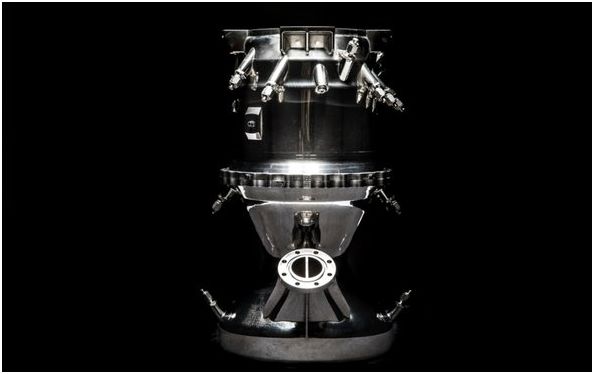
Written by Lee Billings
Translated by Li Yang
Reviewed by Zhang Mengqian
Edited by Wei Xiao
What is the best way to build a rocket?
For Tim Ellis, CEO of the space launch service startup Relativity Space, the answer is clear: print it out.
Ellis and Jordan Noone previously worked together at Blue Origin, a rocket company founded by Amazon billionaire CEO Jeff Bezos. In 2015, Ellis and Noone co-founded Relativity Space. Noone also worked at Elon Musk’s SpaceX. Both Blue Origin and SpaceX utilize 3D printing technology—also known as additive manufacturing—to build some components and tools for their launch vehicles, but both still rely on more traditional techniques for most rocket parts. Given that 3D printed components can be lighter, stronger, and simpler, Ellis and Noone seized the opportunity. They decided to leverage this technology to build cheaper and better rockets that would lower the cost of launching rockets into orbit. They aim to achieve this disruptive dream by designing custom print heads and software.

Relativity Space’s 3D printed rocket engine, Aeon 1. Image source: Relativity Space
After a period of secret preparations, including raising $40 million in venture capital and establishing a 20,000 square foot facility in Los Angeles, Relativity Space is now printing and testing larger rocket components. The company’s patented rocket engine claims to replace 2,600 parts built using standard industrial techniques with just two parts. Just last month, the company signed a $30 million, 20-year agreement with NASA’s Stennis Space Center, securing exclusive use of a 25-acre rocket testing complex. Theoretically, the four test stands at the facility will allow Relativity Space to manufacture enough engines at its own pace, producing 36 rockets per year, and this partnership also allows the company to expand its footprint at Stennis Space Center by tenfold. Such developments are likely timely, as other companies are equally ambitious, planning to fill low Earth orbit with thousands of new satellites for communication, Earth observation, and more.
Relativity Space’s fully 3D printed rocket is not yet complete, let alone launched, but Ellis believes the company will launch its first rocket as early as 2020, shortly followed by commercial cargo flights. He stated that if all goes well, this is just the first step for the company, and their ultimate goal is to print and launch rockets on future Mars colonies, enabling humans to live on multiple planets.
Scientific American recently spoke with Ellis about his plans for Relativity Space, including the emerging market for medium-sized satellites in low Earth orbit and the company’s long-term vision for producing rockets on Mars.

Tim Ellis, CEO of the space launch service startup Relativity Space
Image source: GeekWire
Scientific American (hereafter SA): How is Relativity Space different from other rocket companies?
Tim Ellis (hereafter TE): Relativity Space’s core mission is to create a fundamentally better process for manufacturing and launching rockets. We are working to automate the rocket design and production process, printing as many rocket structures as possible. We see 3D printing as the future of all rocket production and aerospace manufacturing because it reduces the need for labor and simplifies complexity. Currently, the company is developing a platform that combines software, machine learning, metallurgy, and the world’s largest metal 3D printer, which we call “Stargate”. Our patented print heads, software, and metal deposition processes allow “Stargate” to produce parts that are 10 feet in diameter and 20 feet tall, and it is 20 to 30 times faster than traditional 3D printers. Right now, it is the size of our building at headquarters in Los Angeles. Over time, its hardware and software will print larger items at an even faster rate.
SA: How fast can you print now?
TE: We can currently build a nearly 100-foot tall, 7-foot wide (approximately 30 meters tall and 2 meters wide) rocket from scratch in 30 days, with all parts made from 3D printing. Once the parts are printed, our goal is to complete assembly, testing, integration, and launch of the rocket within the next 30 days. Therefore, we hope to manufacture a complete rocket within 60 days from raw materials. We are using “Stargate” to manufacture our own launch vehicle—Terran 1—and a rocket engine called Aeon 1. This will be the foundation of our launch services, initially carrying satellites weighing 1,250 kilograms into low Earth orbit. We plan to announce our launch site by the end of this year, with the first full, performance test flight expected to take place later in 2020, and commercial services to begin in early 2021.

Interior view of the rocket 3D printing platform “Stargate.” Image source: SpaceNews
SA: How much does a launch cost?
TE: Our rocket launches cost $10 million. This price remains highly competitive compared to larger rockets (such as Russia’s Soyuz, Europe’s Vega, and India’s Polar Satellite Launch Vehicle). Those are our competitors in the short term. Some other startups are offering smaller launch rockets, like Rocket Lab’s Electron rocket, which can carry 150 kilograms, but our rocket can carry multiple payloads at once, potentially reducing the price per satellite by two to three times.
SA: It seems you need to launch a large number of satellites to break even. Most satellites are below 1,250 kilograms, or lighter, like CubeSats and other microsatellites, right? How do you meet that demand?
TE: Overall, we observe that there is a higher demand for larger satellites than for smaller ones, as long as they can be built and flown at a low cost. As competition intensifies, we see satellites getting larger—larger optical components, larger sensors, and larger solar arrays provide better performance. But we also see an increasing number of “constellations” of satellites in low Earth orbit for communication or Earth imaging, each consisting of dozens or hundreds, or even thousands of medium-sized spacecraft. This is part of a significant shift in the aerospace industry: from very large satellites in geostationary orbit at nearly 36,000 kilometers to groups of medium-sized satellites flying at altitudes of less than 1,000 kilometers.
SA: What is driving this demand, and how is Relativity Space preparing to meet it?
TE: The urgent need to reduce communication latency is one important factor, lowering latency from hundreds of milliseconds to tens of milliseconds, allowing many applications that rely on satellites to compete with ground options in unprecedented ways. For low Earth orbit, you need a large number of satellites flying in multiple orbits to achieve frequent, complete coverage—you really need to cover the globe to collect and transmit vast amounts of data. For example, SpaceX plans to create Starlink with its Falcon rocket—a constellation of thousands of satellites providing global high-speed broadband connectivity. But SpaceX is not the only company with such plans. Competitors to SpaceX may not necessarily want to use the Falcon rocket. Therefore, we are working on two services, one to replenish constellations with new medium-sized satellites when old satellites fail, and another to deploy entire orbital rings composed of small satellites weighing 50 to 100 kilograms in a single launch. We can accomplish both tasks cost-effectively and have already received over $1 billion in intentions and orders from commercial companies and governments. Due to confidentiality agreements, we cannot discuss much in this area, as the competition in the satellite constellation market is too fierce. However, we will announce our partners in the future.

Satellite constellations in low Earth orbit
SA: Clearly, you are considering long-term goals. Does your 20-year lease at NASA’s Stennis Space Center mean you are planning for 2030?
TE: Precisely, the agreement includes a 10-year term and a 10-year option, during which we can choose to continue or not. This effectively makes it 20 years, as we want to stay here and continue to grow our business! Our design and manufacturing processes are focused on being easily scalable. Therefore, regardless of where the market goes, simplifying this process through robotics and software automation will be the goal for the future, and we will continue to develop the most efficient and best launch vehicles in this location. Ultimately, we want to use our methods to support human habitation on Mars.
SA: Why Mars? What role do you think Relativity Space can play in this?
TE: That is the reason we founded the company. Elon Musk of SpaceX has said, “Hey, we want to go to Mars and build a whole new society there.” They have made incredible progress with the help of NASA over the years. But I want to say that no other company has stepped up to work towards this goal besides SpaceX. We believe it will take more companies—at least dozens—to join this effort and contribute to this long-term mission. Most of the current research seems focused on figuring out how to get people to Mars, but there also needs to be a focus on how to establish a complete permanent society on another planet with a very small workforce. This is the issue that Relativity Space will focus on: how to achieve sustainable development and expansion quickly with minimal labor. Think about what kind of factory you could build on Mars. You would certainly want it to be lightweight, with just the right amount of space, and flexible enough to produce a variety of products in the face of unfamiliar environments. What I just described is precisely a 3D printer, which is what we want to build. Everything we do in our factories on Earth to manufacture rockets and engines is actually the foundation for achieving the same accomplishments on Mars. Ultimately, we want rockets to fly back to Earth from Mars, and a society on Mars must be self-sufficient, which will involve the production and export of goods. If this happens, it will be a pivotal moment in human history. Of course, before that, you could manufacture other industrial products to help establish a complete society on another planet. In pursuing this goal, we can also create a truly remarkable business on Earth.
Original link:
https://www.scientificamerican.com/article/q-a-3-d-printing-rockets-with-relativity-space-ceo-tim-ellis/
Read more
▽ Stories
· An 88-year-old Harvard Medical School professor, ignored by academia and without government funding, continues to promote a new cardiovascular drug that could replace surgery
· A laboratory version of “闲鱼” has launched in North America: those idle resources you don’t need can save others and the Earth
· Can supplementing this hormone from the testicles restore energy and youth in men?
· Shi Yigong officially becomes the first president of Westlake University, with one Nobel laureate and five academicians from the Chinese Academy of Sciences joining the board of trustees
▽ Paper recommendations
· Will artificial intelligence make work environments fairer or more oppressive?
· A green-haired turtle that breathes through its reproductive organ is in urgent danger
▽ Paper guide
· Nature weekly paper guide | April 12, 2018
· Science weekly paper guide | April 13, 2018
For content collaboration, please contact
